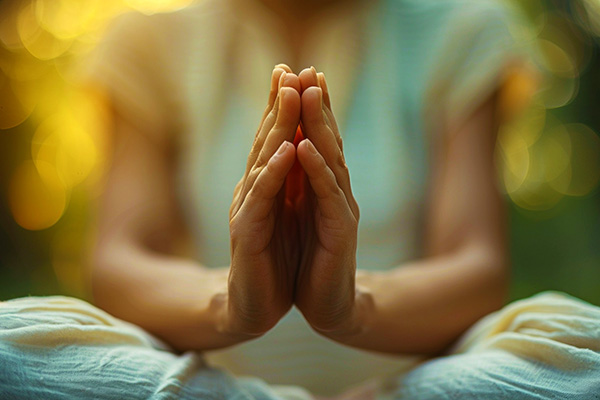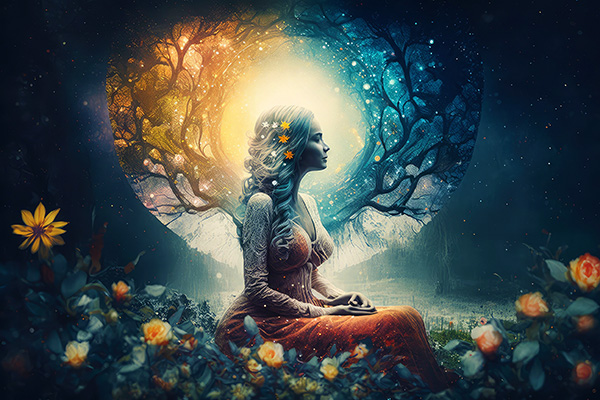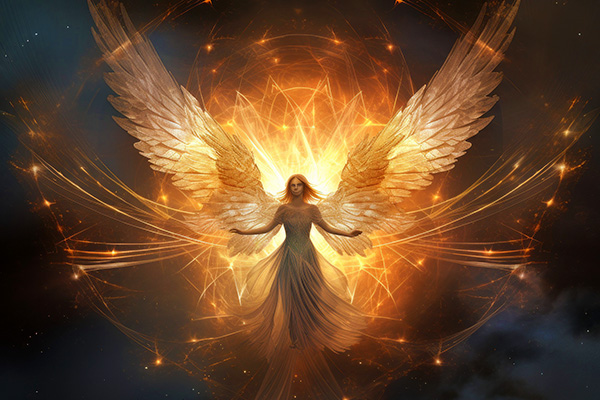Comprehending the Mysterious Phenomenon of Spiritual Shivers
 Shivers and goosebumps are intriguing reactions that the human body experiences, originating from biological functions and physiological responses, yet they also carry an element of enigma.
Shivers and goosebumps are intriguing reactions that the human body experiences, originating from biological functions and physiological responses, yet they also carry an element of enigma.
These bodily reactions are primarily stimulated by low temperatures, intense feelings like fear, excitement, or awe, or as part of the fight-or-flight response.
However, not every instance of trembling, goosebumps, or the “heebie jeebies” stems from physical triggers. Some arise without any clear cause, which hints at a more profound, metaphysical significance.
While scientific explanation links shivers and goosebumps strictly to fundamental survival instincts, a spiritual viewpoint provides a different understanding—one that connects these sensations to supernatural experiences and spiritual interactions.
Goosebumps and shivers trace back to primal responses inherited from our ancient ancestors. When faced with cold, their body hair would elevate to conserve heat and provide warmth.
In the same way, under threat, their hair would rise, making them seem larger and more formidable to predators. We observe this response in the fur of our pets when they enter a fight or flight state. In humans, the mechanism is less pronounced due to our lower hair density, but the reaction remains intact.
This process, known as piloerection, causes the tiny muscles at the base of hair follicles to contract, resulting in hair standing on end and forming the distinctive bumps we refer to as goosebumps—so named because they resemble the skin of de-feathered poultry. This response falls under the realm of the body’s autonomic nervous system, which governs involuntary actions.
You possess strong intuition, and you not only perceive their presence but also physically feel it. There is no cause for distress. If you’re curious, engage with the sensation and discover what it reveals ~ Crystal Anne Compton
From a spiritual perspective, chills and goosebumps can occasionally denote an encounter with spiritual energy or presence. Across various cultures, these sensations are thought to signal the nearness of a spirit, angel, or other supernatural entity. Our light body, or aura, has the capacity to sense subtle energy shifts in our surroundings, and chills or goosebumps are the physical expressions of these encounters.
The Experience of Spiritual Chills
Have you ever felt a shiver cascade down your spine or goosebumps suddenly appear without any logical explanation? These sensations, often referred to as “spiritual chills,” extend beyond mere biological causes. They may indicate a spiritual message, divine direction, or an intuitive prompt.
Spiritual chills transcend simple physical reactions; they can be significant markers of spiritual activity and metaphysical truths. These reactions generally arise during periods of heightened spiritual or psychic awareness when we are especially attuned to metaphysical energies or events.
Unlike chills resulting from cold or fear, spiritual chills carry a distinctive, purposeful essence. They serve as bodily manifestations of shifts in metaphysical energy, spiritual messages, otherworldly entities, or intuitive insights. Goosebumps and shivers remind us of the profound link between the physical and spiritual realms. Although grounded in biological survival, their spiritual importance lies in connection, intuition, and divine guidance.
Grasping the various triggers of these sensations can assist you in interpreting their significance and responding accordingly. Below are several common types of spiritual phenomena that may induce chills and goosebumps:
Spirit Presence
When our beloved departed, ancestors, spirit guides, or angels seek to connect with us, they frequently do so subtly through sensations like chills or tingles that signal the closeness of spiritual entities offering support or affirmation.
For instance, you might experience a surge of chills while contemplating a major life decision or during a moment of appreciation. These sensations often provide gentle reassurance that you are being watched over and guided.
Energy Shifts
Spiritual shifts may occur upon entering a space with a strong energetic imprint or residue. This can take place in locations steeped in intense emotions, such as historic buildings, sacred sites, or places known for significant past events.
At times, these tremors indicate a positive energy transformation, such as in a tranquil temple or serene natural setting. Conversely, they may serve as a caution about negative or stagnant energy present in the area.
Paranormal Encounters
While spiritual chills typically signify the presence of a deceased loved one or guide, there can be instances where they result from an unwelcome energy presence. Encounters with negative or malevolent spirit entities often lead to particularly strong chills and goosebumps.
If a passed loved one is close, the chill is usually comforting or nostalgic, accompanied by memories or a sense of familiarity. Conversely, an unsettling chill typically implies the presence of a spiritual entity misaligned with your energy. In such situations, you may want to take steps to cleanse and protect your energy and living space.
Psychic Perception
Psychic abilities like clairvoyance or clairsentience frequently manifest through bodily sensations. Chills may occur as a form of intuitive validation, indicating that a thought, emotion, or impression is accurate.
For example, if you are weighing a decision and feel goosebumps while reflecting on a particular option, this might be a psychic prompt affirming your choice. These sensations signal your body’s alignment with higher truths.
Past Life Memories
Occasionally, unexplainable chills or goosebumps may arise from a profound soul memory or connection to a past life. This can happen when you encounter someone or something that resonates deeply with your soul’s journey.
For instance, visiting a historical site or meeting a stranger who feels oddly familiar can trigger these sensations, indicating a spiritual recognition or karmic bond.
Energetic Alignment
Powerful emotional resonance with music, art, or moments of profound beauty may also elicit spiritual chills. This sensation occurs when your energy aligns harmoniously with something that elevates your vibration, like hearing an impactful song, witnessing kindness, or experiencing breathtaking natural scenery. These chills often invoke uplifting and affirming feelings, reminding you of your connection to the Spirit and the Divine, as well as life’s beauty.
Chills may also denote alignment with high vibrational frequencies, such as during meditation, Reiki sessions, or spiritual rituals. When your energy field vibrates in sync with these elevated frequencies, physical responses like tingling sensations, chills, or goosebumps may follow. These experiences often bring about uplifting and transformative feelings, instilling serenity and clarity.
Signs & Synchronicities
Recognizing signs and synchronicities can trigger chills, such as spotting recurring angel numbers, encountering your spirit animal, or experiencing “coincidences” that resonate too powerfully to ignore. Such moments often affirm that you are on the right path, aligned with the universe’s flow, and your body responds with chills or goosebumps.
Psychic Experiences
Spiritual chills may manifest during moments of premonition or foresight, signaling that something significant looms on the horizon. For instance, if you feel chills while envisioning a future occurrence or during a seemingly ordinary moment, it may indicate that you are connecting with a future timeline or participating in a moment of destiny.
The presence of the Spirit: it cannot be surmised, how may it be ignored! Such is the evidence of things invisible that it is impossible to doubt the spiritual nature of man ~ Confucius
Interpreting the Significance of Spiritual Chills
The challenge lies in accurately interpreting the deeper meaning of these sensations. To decipher their significance, consider the context and your emotional state in the moment. Take a moment to evaluate what is happening both internally and in your surroundings.
Pause and reflect: When you feel spiritual chills, take a moment to pause. Observe your immediate environment, emotions, and thoughts. Where are you? Focus on your surroundings. What transpires around you? Look for external hints such as patterns, synchronicities, or sensory clues. What thoughts or emotions surface?
Trust your intuition: Listen to your instincts. If a place or situation feels “off,” it likely is.
Ask for clarity: If the message remains unclear, silently ask your angels or spirit guides for more distinct guidance.
Document the experience: Maintain a journal to record instances of feeling spiritual chills. Over time, patterns may arise that enhance your understanding of their meaning.
Stay open and aware: Messages can materialize in various forms—dreams, symbols, or recurring numbers. Remaining receptive ensures you do not overlook these signals.
If you experience sudden shivers or goosebumps, especially during emotionally charged or reflective instances, consider them mystical nudges. They might be drawing your attention to overlooked aspects, providing comfort, or urging you to redirect your path. By remaining attuned to these sensations and their triggers, you can interpret their messages more effectively, deepen your spiritual awareness, and strengthen your connection to unseeable realms.
For example, if you walk into a room and feel an uncomfortable sense of unease accompanied by chills, this might serve as a warning to exercise caution. The room’s energy—or the intentions of its occupants—may not align with your well-being. Similarly, chills can validate a decision you are considering. If you’re pondering a significant life choice and suddenly feel a rush of goosebumps when contemplating one option, it could be a sign that you’re heading in the right direction.
Keep an open mind and a trusting heart. As you grow more attuned to the signals your body communicates and their context, you will cultivate a clearer understanding of when these shivers are spiritually meaningful.
By taking notice of these subtle cues, we open ourselves to the profound wisdom of the universe. Angels, spirit guides, and our higher selves are consistently supporting us, nudging us towards decisions that serve our highest good. The next time you feel an unexpected chill or a wave of goosebumps, pause and listen. What message could the Universe be conveying to you?
The language of chills and goosebumps is steeped in mystery and insight—a reminder that we are never alone on our journey and that guidance is always accessible if we choose to heed it.
|
Venus resides in Arizona and has utilized her array of psychic abilities to assist clients for over twenty years. She possesses Clairvoyance, Clairaudience, Clairsentience, and Empathic gifts, in addition to being a certified Life Coach and Reiki practitioner. Often, departed loved ones will appear in her readings, whether invited or spontaneously, to convey their messages. She also connects directly with Spirit and Angels, delivering clients the insights they seek to propel them towards joy, rewards, and success. Beyond her roles as a psychic, life coach, and Reiki practitioner, she has dedicated the last decade to teaching and leading seminars aimed at helping others embrace their higher wisdom. If you desire a compassionate psychic capable of immediate tuning and channeling without tools, you will want to schedule a reading with Venus at: PsychicAccess.com. |

















